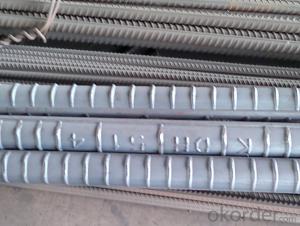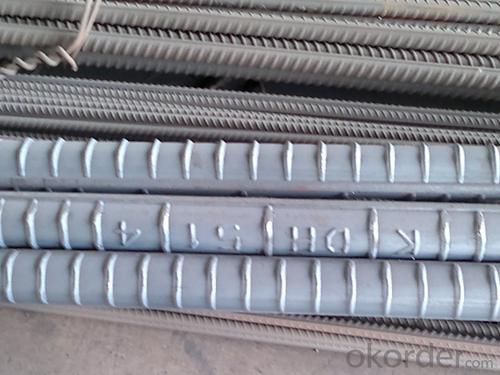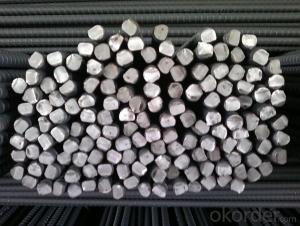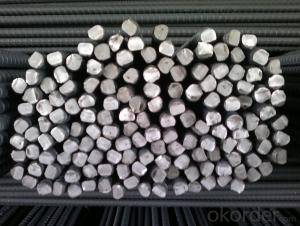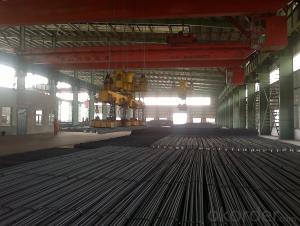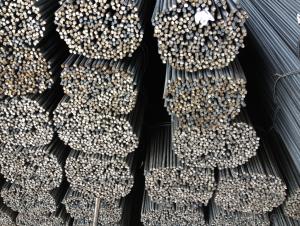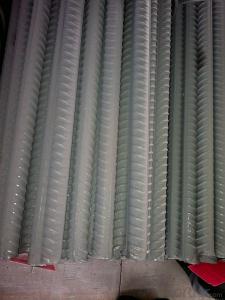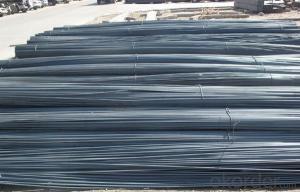ASTM, GB Standard Hot Rolled Deformed Steel Rebars
- Loading Port:
- Lianyungang
- Payment Terms:
- TT OR LC
- Min Order Qty:
- 25 m.t.
- Supply Capability:
- 200000 m.t./month
OKorder Service Pledge
OKorder Financial Service
You Might Also Like
Specifications of ASTM, GB Standard Hot Rolled Deformed Steel Rebars:
Standard | GB | HRB400 | |
Diameter | 6mm,8mm,10mm,12mm,14mm,16mm,18mm,20mm, 22mm,25mm,28mm,32mm,36mm,40mm,50mm | ||
Length | 6M, 9M,12M or as required | ||
Place of origin | Hebei, China mainland | ||
Advantages | exact size, regular package, chemical and mechanical properties are stable. | ||
Type | Hot rolled deformed steel bar | ||
Brand name | DRAGON | ||
Chemical Composition: (Please kindly find our chemistry of our material based on HRB500 as below for your information)
Grade | Technical data of the original chemical composition (%) | ||||||
C | Mn | Si | S | P | V | ||
HRB400 | ≤0.25 | ≤1.60 | ≤0.80 | ≤0.045 | ≤0.045 | 0.04-0.12 | |
Physical capability | |||||||
Yield Strength (N/cm²) | Tensile Strength (N/cm²) | Elongation (%) | |||||
≥400 | ≥570 | ≥14 | |||||
Theoretical weight and section area of each diameter as below for your information:
Diameter(mm) | Section area (mm²) | Mass(kg/m) | Weight of 12m bar(kg) |
6 | 28.27 | 0.222 | 2.664 |
8 | 50.27 | 0.395 | 4.74 |
10 | 78.54 | 0.617 | 7.404 |
12 | 113.1 | 0.888 | 10.656 |
14 | 153.9 | 1.21 | 14.52 |
16 | 201.1 | 1.58 | 18.96 |
18 | 254.5 | 2.00 | 24 |
20 | 314.2 | 2.47 | 29.64 |
22 | 380.1 | 2.98 | 35.76 |
25 | 490.9 | 3.85 | 46.2 |
28 | 615.8 | 4.83 | 57.96 |
32 | 804.2 | 6.31 | 75.72 |
36 | 1018 | 7.99 | 98.88 |
40 | 1257 | 9.87 | 118.44 |
50 | 1964 | 15.42 | 185.04 |
Usage and Applications of ASTM, GB Standard Hot Rolled Deformed Steel Rebars:
Deformed bar is widely used in buildings, bridges, roads and other engineering construction. Big to highways, railways, bridges, culverts, tunnels, public facilities such as flood control, dam, small to housing construction, beam, column, wall and the foundation of the plate, deformed bar is an integral structure material. With the development of world economy and the vigorous development of infrastructure construction, real estate, the demand for deformed bar will be larger and larger..
Packaging & Delivery of ASTM, GB Standard Hot Rolled Deformed Steel Rebars:
Packaging Detail: products are packed in bundle and then shipped by container or bulk vessel, deformed bar is usually naked strapping delivery, when storing, please pay attention to moisture proof. The performance of rust will produce adverse effect.
Each bundle weight: 2-3MT, or as required
Payment term: TT or L/C
Delivery Detail: within 45 days after received advanced payment or LC.
Label: to be specified by customer, generally, each bundle has 1-2 labels
Trade terms: FOB, CFR, CIF
Deformed Steel Bar in container
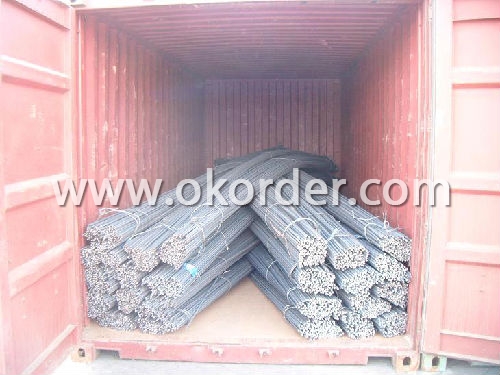
Deformed Steel Bar in factory
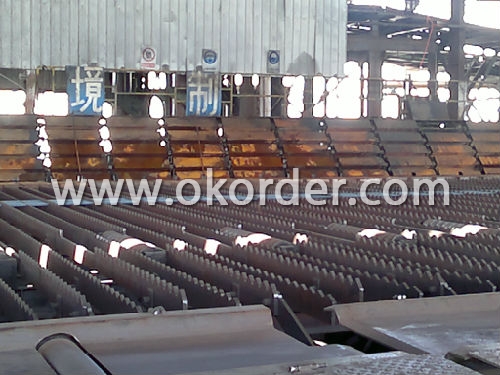
Note:
1. Our products are produced according to national standard (GB), if not, supply according to national standards (GB) or agreement as customer required.
2. Other Grade and Standard Deformed Steel Bar we can supply:
Grade: GR40/GR60, G460B/B500A/B500B/B500C,BST500S
Standard: ASTM, BS, DIN
The Minimum Order Quantity of these products is high, and need to be confirmed.
3. We can not only supply Deformed Steel Bar; if you need anything about building materials, please contact us for further information.
4. Please send us your detail specifications when inquire. We will reply to you as soon as possible. We sincerely hope we can establish a long stable business relationship.
- Q: What are the guidelines for reinforcing concrete slabs with steel rebars?
- The guidelines for reinforcing concrete slabs with steel rebars involve several key considerations. Firstly, it is important to determine the required amount of reinforcement based on the load that the slab will be subjected to. This load can be calculated using structural engineering principles and taking into account factors such as the intended use of the slab, the weight of any equipment or vehicles that will be placed on it, and any applicable building codes or regulations. Once the required amount of reinforcement is determined, the next step is to design the layout of the rebars. This involves spacing the rebars at specified intervals to ensure uniform distribution of the load across the slab. The spacing will depend on the thickness of the slab, with thicker slabs generally requiring a greater number of rebars. Additionally, it is important to include minimum clearances between the rebars and the edges or bottom of the slab to prevent corrosion and ensure proper concrete cover. The size and type of rebars used is also an important consideration. Commonly used types include plain round bars, deformed bars, or welded wire fabric. The diameter of the rebars and the grade of steel should be selected based on the expected load and the requirements of the project specifications or building codes. During the construction process, it is crucial to properly place and secure the rebars within the formwork to maintain their intended position. This may involve the use of chairs, spacers, or other devices to ensure proper alignment and prevent displacement. Additionally, care should be taken to avoid any damage to the rebars during the concrete pouring and finishing process. Finally, it is important to inspect and test the reinforced concrete slab to ensure that the rebars are properly installed and meet the required specifications. This may involve visual inspections, as well as non-destructive testing methods such as ultrasound or ground-penetrating radar to verify the integrity and position of the rebars. Overall, following these guidelines for reinforcing concrete slabs with steel rebars will help to ensure the structural integrity and longevity of the slab, while also meeting the necessary safety and building code requirements.
- Q: How do steel rebars contribute to the overall seismic resistance of a structure?
- Steel rebars contribute to the overall seismic resistance of a structure by providing reinforcement and strength to the concrete elements. The rebars help to distribute and dissipate the energy generated during an earthquake, which helps in reducing the potential damage and ensuring structural integrity. By increasing the ductility and flexural capacity of the structure, steel rebars help to absorb and withstand the seismic forces, making the building more resistant to collapse or significant structural damage.
- Q: Can steel rebars be used in structures with high fire safety requirements?
- Yes, steel rebars can be used in structures with high fire safety requirements. Steel has a high melting point and good fire resistance properties, making it suitable for use in fire-resistant structures. Additionally, steel rebars can be encased in fire-resistant materials such as concrete or intumescent coatings to enhance their fire resistance capabilities.
- Q: Can steel rebars be used in wastewater storage tanks?
- Indeed, wastewater storage tanks can utilize steel rebars. These rebars are frequently employed as reinforcement in concrete structures, including wastewater storage tanks. By imparting tensile strength to the concrete, the rebars enhance its resistance to cracking and bolster the overall structural integrity of the tank. Moreover, steel rebars possess corrosion-resistant properties, a crucial attribute given the inevitable exposure to corrosive elements in wastewater storage tanks. Consequently, the utilization of steel rebars in these tanks is a prevalent and efficacious practice within the construction industry.
- Q: How do steel rebars perform in heavy load-bearing structures?
- Steel rebars perform exceptionally well in heavy load-bearing structures. They offer high tensile strength, durability, and excellent resistance to corrosion. These properties enable rebars to effectively withstand heavy loads and provide structural stability, ensuring the long-term integrity of the structure.
- Q: Can steel rebars be used in wastewater storage tanks?
- Yes, steel rebars can be used in wastewater storage tanks.
- Q: How do steel rebars contribute to the overall ductility of a structure?
- Steel rebars contribute to the overall ductility of a structure by providing reinforcement and enhancing its ability to withstand deformations and absorb energy without failure. The addition of rebars in concrete structures improves its tensile strength, as concrete alone is weak in tension. This combination allows the structure to flex and bend under loading, reducing the risk of brittle failure and increasing its overall resilience.
- Q: Are steel rebars prone to expansion and contraction?
- Yes, steel rebars are prone to expansion and contraction due to changes in temperature.
- Q: How are steel rebars cut and bent on-site?
- Steel rebars are cut and bent on-site using specialized tools and equipment. The process typically involves the following steps: 1. Measurement: The rebars are measured according to the required length and dimensions specified in the construction plans. This is crucial to ensure accuracy and precision in the bending and cutting process. 2. Cutting: Rebars can be cut using different tools such as manual rebar cutters, hydraulic shears, or portable electric cutters. These tools are designed to provide clean and precise cuts without causing damage to the rebars. The rebars are positioned securely, and the cutting tool is applied to the marked area, resulting in the desired length. 3. Bending: Once the rebars are cut to the required length, they are bent using rebar benders. These machines have various attachments and rollers that can shape the rebars according to the desired angle and radius. The rebars are carefully positioned and secured in the bender, and the machine exerts force to bend them to the specified shape. 4. Quality control: After cutting and bending, the rebars undergo quality control checks to ensure they meet the required specifications. This may involve visual inspections, measurements, and testing to verify the accuracy of the dimensions and the quality of the cuts and bends. It is important to note that skilled workers, such as ironworkers or steel fixers, are typically responsible for the on-site cutting and bending of rebars. They have the expertise to interpret construction plans, use the appropriate tools, and ensure that the rebars are cut and bent accurately to meet the project's needs.
- Q: Can steel rebars be bent without compromising their strength?
- Yes, steel rebars can be bent without compromising their strength. Steel rebars are designed to have a high tensile strength, which allows them to withstand bending and stretching forces without breaking or losing their structural integrity. The bending process involves applying a controlled amount of force to the rebar, which causes the material to deform and take on a new shape. However, it is important to ensure that the bending is done within the recommended limits and guidelines provided by the manufacturer or industry standards. Excessive bending beyond the specified limits can lead to microcracks or other defects that may compromise the strength of the rebar. Therefore, it is crucial to follow proper bending techniques and use the appropriate equipment to ensure that the steel rebars maintain their strength even after being bent.
Send your message to us
ASTM, GB Standard Hot Rolled Deformed Steel Rebars
- Loading Port:
- Lianyungang
- Payment Terms:
- TT OR LC
- Min Order Qty:
- 25 m.t.
- Supply Capability:
- 200000 m.t./month
OKorder Service Pledge
OKorder Financial Service
Similar products
Hot products
Hot Searches
Related keywords
